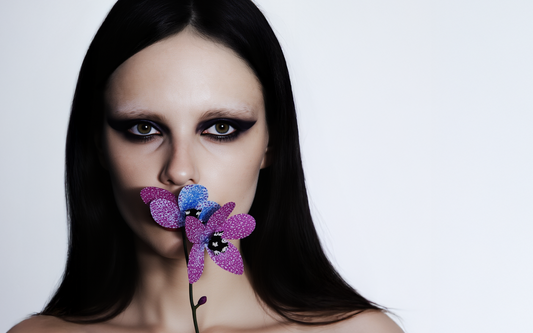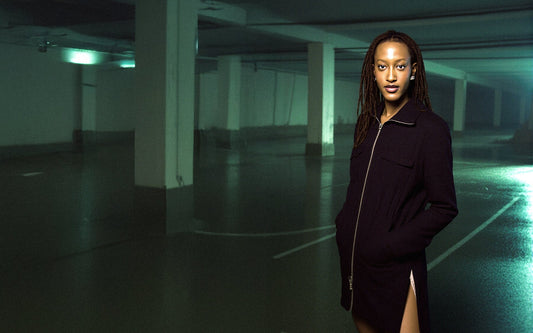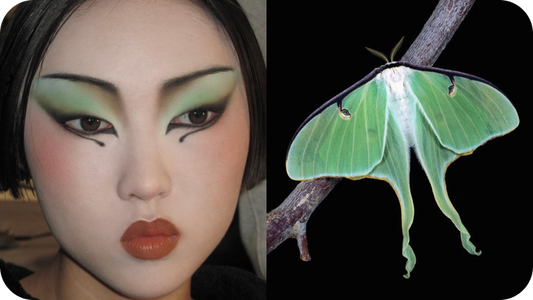If there’s anyone you would want doing your make-up, either on the physical plane or in a digital realm, it’s Ana Takahashi.
DAZED Beauty editor, Alex Peters, discusses our latest collaboration and future of beauty with makeup artist Ana Takahashi.
Ana Takahashi is known for creating out of the ordinary characters. You’ve likely seen her work on Charli XCX, Timothée Chalamet, Drew Starkey, or Caroline Polachek. Always bold and experimental, the London-based make-up artist masterfully harnesses colour and light to produce work that is at the same time exquisitely beautiful and endlessly creative.
For Studio Halia’s anticipated DROP 02, Hugo Kreit created a three-piece accessory collection with a connected augmented reality beauty experience, and Takahashi was the natural choice to collaborate with to design the make-up. The result is “living make-up” looks that seem to originate from within our very selves, playing with light to enhance and customise – without ever altering – the face and create skin that almost glows from the inside-out.
Here, Takahashi speaks to Studio Halia about her creative process for designing the make-up looks for the project, as well as how her personal love of video games like Death Stranding – and the way the characters are physically changed by their surroundings – influenced how she conceived of the designs. She also discusses how increasing advanced digital technology and AI might impact the fashion and beauty industry in the coming years.

Alex Peters: What was the creative process for this project like? What concept did you start off with and how did you build the make-up looks from there?
Ana Takahashi: It was very much informed by Hugo Kreit, the jewelry designer, and their (Hugo Kreit & Nordine Makhloufi, the co-founders of Hugo Kreit) intentions for the collection. The word that he would always bring up was ‘organic’. They wanted the shapes to feel like they were very natural and ever-changing, and they would look different in different lights and on different faces.
So that was my starting point. I wanted something that felt like it was attached to the body and came from within. We started thinking about pushing shapes out from under the skin, or creating a glow from underneath. Like when you shine a torch on your skin and it makes it glow red. So it was all about how to make it feel like it was becoming part of the body, like you had this chip inside of you and depending on which one you activated it creates a glow within the skin.
Alex Peters: I love the organic shapes and colours because digital looks often try to be ultra futuristic and artificial.
Ana Takahashi: We wanted to do something that still felt, at the end of the day, beautiful and would not totally eradicate your face. It would just, if anything, enhance it, because the light is all about enhancing and working with what you have already. We talked about doing face-altering filters, something that could make your mouth shape change or change the colour of your eyes. But we decided against that in the end, because we wanted it to enhance what the user already has, just make them look at themselves in a different way. How does this colour make me feel or make me look? But never changing the actual shapes of the person's face.
Alex Peters: The looks that you created are described as ‘living make-up’. Is that an idea you were thinking about while you were creating them?
Ana Takahashi: Yeah, the idea of the make-up was, again, this activation thing. So if you were to connect to the jewelry, how could the make-up move and live and breathe with the person. If they opened their mouths would something change? Would the colour pulsate? If you blinked would these organic shapes start moving or flutter or pulsate like a heartbeat?

Alex Peters: The amazing thing about digital make-up and AR technology is that people can express themselves in any number of endless creative ways. But it can also be used to help people adhere to very traditional ideas of beauty – filters that make your lips bigger, nose smaller etc. How do you see this technology influencing beauty trends in the future?
Ana Takahashi: Do you know about that retouch filter on TikTok? I didn't know that it was putting that on my video but it just goes on automatically, and you have to unselect it if you want it to come off. So that side of it is so scary. I was 13 or 14 when I first had Instagram and that, in itself, had an affect on me and how I see myself. So I can't even imagine if you're a teenager now, with things like the extreme glamor filters.
But I can also see how it can positively affect someone's creativity. We saw it with the Margiela Pat McGrath make-up, the shiny skin. She said that it was inspired by porcelain dolls but definitely there was an element to it that felt like an Instagram filter. And I think that's why it was so fascinating, because that kind of application felt impossible in real life, and she made it possible. So it's all about how can we push boundaries? And filters can be a direct inspiration for that.
When I first saw Ines Alpha’s filters, I was starting my career and it really inspired my work. I would try to create the filters in the physical. Obviously some looks are just impossible – you can't do the ones where she's got things flying around the head or bubbles coming out of your ears. But there was a duo chrome filter that Ines Alpha did, that I recreated with make-up, and that was something that I hadn't really thought of doing until I saw the filter. So that is a way in which AR technology can directly inspire you, trying to mix the physical and the digital.
Alex: You are a big fan of video games and they often inspire your work. Did that impact the looks or your concept of them?
Ana Takahashi: 100%. Death Stranding was definitely in the back of my mind, because the main character is very connected to this technology that he's dependent on and it also alters him. When monsters are close, you'll see black tears dropping on his face. And the rain is dangerous, it ages your skin if you go in the rain. So it's the physical world affecting your body, your face. So definitely there's inspiration there. All my images [for the project] kind of look like video game screenshots, although they're not. I made all those photos on Midjourney, so they're all AI generated. [Doing the sketches] physically with a pen and paper wouldn’t have been impossible.

Alex Peters: Have you been using Midjourney more in your projects?
Ana Takahashi: No, this was the last thing I did it for because, honestly, it kind of scared me how easy it is and how many new ideas it gives you. I don't want to use that as a crutch in my work. I don't want to become so dependent on it. So I do try to reject AI technology, which can anyway start to feel quite soulless. However, for this project, for specific things, it's amazing. I did go in afterwards on Photoshop and I changed the colours, I changed some of the textures. So the finished product wasn't just from Midjourney.
I'm scared of relying on it too much because, you know, when iPhones came out with spell check, I basically can't spell anymore because I rely on my phone to just auto-correct everything for me. And I think I see that happening also with AI, we're just going to become too dependent on it. I’ve never downloaded ChatGPT, and I probably never will, because I don't want to have to rely on something so much to help me. So I'm trying to prevent that from happening in my creative process. I think it's important to touch grass, go outside and be inspired by the physical.
Alex Peters: How do you see technology like these impacting your work and the wider industry in the future?
Ana Takahashi: AI brings up this conversation of copyright. When I was doing the Midjourney stuff, you have to give the AI prompts, so [brands that use AI to create their campaign images] have to feed them images of a model that already exists. And then say you use AI for a make-up campaign. Does that mean that they're using screenshots from make-up artists’ Instagrams to develop the looks? And the answer is probably yes. So not only does it eradicate your work, it also is probably stealing your work or your identity as a model, as a make-up artist, as a photographer. Someone could say ‘create an image in the likeness of a Harley Weir 2023 cover photoshoot’, and then it will do that.
As photographers, creatives, makeup-artists, we are planning for weeks, sometimes months, thinking about images that then AI can just snatch in two seconds to create a whole new photoshoot. So it's very scary, and the copyright thing worries me more than anything. But then, a project like this can be used in a very positive way, so it's just where we want to take it. But we are human, so we're probably inherently going to make it negative and use it for bad.
Alex Peters: If history has taught us anything!
Ana Takahashi: Exactly, if we have this new superpower, we will use it for bad.
 Log in
Log in



